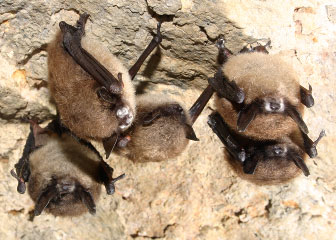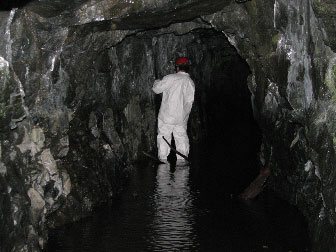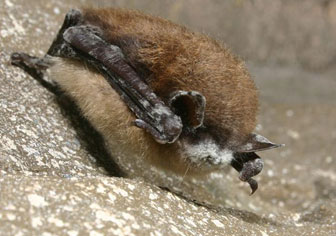Researchers have identified the fungus that may have been the culprit in mass die-offs of bats in the northeastern United States during the winter of 2006-2007. The research is published in this week’s issue of Science.
During the outbreak, which killed 100,000 hibernating bats, many bats were afflicted with “white-nose” syndrome — a white, powdery-looking substance on their muzzles, ears and wings. As many as 97 percent of bats in some caves succumbed to the infection. The cause was a mystery ̵ until now.
Collecting samples of the fungus from over 100 bats, David Blehert and colleagues cultured the fungus in the lab and found it belongs to the Geomyces genus and prefers cold temperatures — warmer temperatures inhibit it.

Little brown bats in NY cave. [Images courtesy of Al Hicks, NY DEC] |
While the researchers have now identified the fungus it still isn’t clear whether it was the only factor in bat deaths. Nor are they sure of its origin.
“This fungus may have been recently introduced to bat hibernation caves and, if so, human and animal movements among these caves are causes that need to be considered,” said Blehert, a microbiologist at the U.S. Geological Survey. “Data show the occurrence of white-nose syndrome radiating outward from the site of its first appearance, and genetic identity among fungal isolates from distant caves argues for a recent introduction of this microbe. Before the identification of white-nose syndrome, mass mortality events in bats as a result of disease were very rare.”
Die-offs of bats are a concern due to their critical ecological roles in insect control, plant pollination and seed dissemination. Many important food crops are pollinated or dispersed by bats — especially in the tropics — while bats also helping protect against mosquito-borne disease like malaria.

Kim Miller collecting environmental samples in an abandoned mine where bats hibernate in NY. [Image courtesy of USGS] |
“Right now we are uncertain about the long-term effects of white-nose syndrome on North American bats, but we are quite concerned about future effects on bat populations wherever environmental conditions are conducive to growth of the fungus.” said Blehert. “To manage and perhaps halt this disease, we have to first better understand it.”
D.S. Blehert et al (2008). Bat White-Nose Syndrome: An Emerging Fungal Pathogen. SCIENCE 31 OCT 2008















